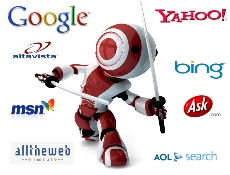 We’ve all heard some variation of the old saying “change is the only constant.” Let me tell you; the marketing world is one of the most glaring examples.
We’ve all heard some variation of the old saying “change is the only constant.” Let me tell you; the marketing world is one of the most glaring examples.
The methods by which people gather information before making purchasing decisions is 100% different than it was, just a couple of decades ago.
For this reason, we have no choice as marketers but to get with the times, educate ourselves on the “latest and greatest” and ultimately change our tactics.
Wikipedia defines the term “lead generation” as “the generation of consumer interest or inquiry into products or services of a business“. In other words, people who have expressed potential interest in buying from YOU. Play your cards right and you’ve got yourself a sale!

In 1994, when a business set to task finding new customers their Sales team had a variety of options to choose from when deciding the best way to load up the funnel. Common “tried and true” methods included media advertising, telemarketing, direct mail, industry trade shows, video “dog and pony” brochures, catalogs and personal (door to door) selling. Considered “outbound” marketing techniques, the company’s message is sent or presented TO a prospect.
Outbound marketing techniques are regarded as expensive and directly reflect the level of technology available in the early ‘90’s.
 Ever heard the old “spaghetti” theory? Maybe you’ve heard it in different words - throw enough spaghetti at a wall, something is bound to stick. Many outbound techniques were designed to work in much the same way. Volume was key because marketers didn’t know who would see their commercial or receive their mailer. The more you send out, the more you saturate the market with your branding, product or service, the more likely you were to get a bite on the end of your line. Not really a good way to drum up business, if you ask me. Crossing your fingers that your message ends up under the nose of the correct person with a current need for what you’re offering who happens to be ready to buy? Good luck!
Ever heard the old “spaghetti” theory? Maybe you’ve heard it in different words - throw enough spaghetti at a wall, something is bound to stick. Many outbound techniques were designed to work in much the same way. Volume was key because marketers didn’t know who would see their commercial or receive their mailer. The more you send out, the more you saturate the market with your branding, product or service, the more likely you were to get a bite on the end of your line. Not really a good way to drum up business, if you ask me. Crossing your fingers that your message ends up under the nose of the correct person with a current need for what you’re offering who happens to be ready to buy? Good luck!
 But often it worked, receiving a post card advertising a local lawn care service, on that sweltering hot day after you just finished mowing your lawn. Maybe you raised an eyebrow. Maybe you called the number on the card and maybe you’ll never have to mow your own lawn again (for a price, of course). That business just made a return on their marketing investment, solely by being in your hands at the right time. There was no Google search to research other lawn care companies who serve your area, no way to ensure you were being charged a fair price, no Angie’s List to advise you on the reputation of the company you were about to hire. BUT, you had that specific company’s postcard in front of you, when it mattered, not their competitor’s… look who got your business.
But often it worked, receiving a post card advertising a local lawn care service, on that sweltering hot day after you just finished mowing your lawn. Maybe you raised an eyebrow. Maybe you called the number on the card and maybe you’ll never have to mow your own lawn again (for a price, of course). That business just made a return on their marketing investment, solely by being in your hands at the right time. There was no Google search to research other lawn care companies who serve your area, no way to ensure you were being charged a fair price, no Angie’s List to advise you on the reputation of the company you were about to hire. BUT, you had that specific company’s postcard in front of you, when it mattered, not their competitor’s… look who got your business.
Enter the digital age.
 Over the years, the Internet gave birth to Social Media, Search Engines and the rise of e-Commerce. In 20+ years, the game has changed, completely. The web is everywhere. Our computers, phones, homes, cars – they’re all connected. This shift in cultural norms has reshaped the way we as consumers make purchasing decisions. 10 years ago, it was rare to make a purchase “online.” 20+ years ago, it was unheard of. It just didn’t happen.
Over the years, the Internet gave birth to Social Media, Search Engines and the rise of e-Commerce. In 20+ years, the game has changed, completely. The web is everywhere. Our computers, phones, homes, cars – they’re all connected. This shift in cultural norms has reshaped the way we as consumers make purchasing decisions. 10 years ago, it was rare to make a purchase “online.” 20+ years ago, it was unheard of. It just didn’t happen.
Today, many of us are completely comfortable making online purchases. We do our holiday shopping, purchase books and music, concert tickets… almost anything you can think of, you’ll find on the web. Not only will you find what you’re looking for, you will probably find multiple outlets to purchase from. There is no shortage of options, that’s for sure.

Let’s revisit the lawn care example, in 2017. It’s another stiflingly hot afternoon, you’ve just finished mowing the lawn, you’re drenched in sweat and cursing yourself for waiting so many days to mow. You made it 10 times worse on yourself, because the grass was so tall! Walking back into your nice, cool, air conditioned house triggers a light bulb moment, a minor epiphany of sorts: I could pay someone else to do this task that I hate so much!
 There you have it folks, a need. A customer’s pain point that can be solved by purchasing a product or service! You sit behind your computer, armed with your best search engine Ninja skills and type in the phrase “cost for weekly lawn care service” to spice it up, you add your zip code to bring up local results. What do you get in return for your search? Ten pages containing over 200,000 results (insert overwhelmed eye-roll here). Noting that you have some research to do, you begin to wade through the top few links on the page.
There you have it folks, a need. A customer’s pain point that can be solved by purchasing a product or service! You sit behind your computer, armed with your best search engine Ninja skills and type in the phrase “cost for weekly lawn care service” to spice it up, you add your zip code to bring up local results. What do you get in return for your search? Ten pages containing over 200,000 results (insert overwhelmed eye-roll here). Noting that you have some research to do, you begin to wade through the top few links on the page.
 You’ve begun the process of engaging local companies in an effort to educate yourself on all of your options before making the final decision which company to hire. Then, while reviewing yet another company’s site you stumble upon a blog post titled “Factors to consider when choosing a lawn care company.” Wow, a breath of fresh air. Most of these companies don’t have blogs at all, let alone information on how to make an informed decision, whether it be their company or another in the area. Nice!
You’ve begun the process of engaging local companies in an effort to educate yourself on all of your options before making the final decision which company to hire. Then, while reviewing yet another company’s site you stumble upon a blog post titled “Factors to consider when choosing a lawn care company.” Wow, a breath of fresh air. Most of these companies don’t have blogs at all, let alone information on how to make an informed decision, whether it be their company or another in the area. Nice!
 Now let’s examine this scenario from the lawn care company’s perspective. You’re the new marketing whiz at a mid-size local landscaping company. You know that buyers today go online to find solutions to their needs, when and where those needs arise. You’ve done your homework and your due diligence setting up and optimizing your company’s website to be found on the first page on the Google results. Your site has testimonials, a visual portfolio and a well-established blog, regularly updated and full of posts with tips and pointers on everything from gardening to landscaping, DIY projects and advice on when to seek professional help. You’re educated on the most recent marketing best practices and put them to work for your business, flawlessly.
Now let’s examine this scenario from the lawn care company’s perspective. You’re the new marketing whiz at a mid-size local landscaping company. You know that buyers today go online to find solutions to their needs, when and where those needs arise. You’ve done your homework and your due diligence setting up and optimizing your company’s website to be found on the first page on the Google results. Your site has testimonials, a visual portfolio and a well-established blog, regularly updated and full of posts with tips and pointers on everything from gardening to landscaping, DIY projects and advice on when to seek professional help. You’re educated on the most recent marketing best practices and put them to work for your business, flawlessly.
Visitors didn’t get to your website by accident.
They’re searching for a solution to a specific and current need. With a wealth of options at the buyer’s fingertips, you’ve taken steps to differentiate your company in a BIG way. By using landing pages, calls to action and forms to collect prospective clients personal information, you’ve harnessed the ability to turn a visit to your website into a sales-qualified lead by exchanging your educational content for their name, email address and telephone number.

It’s a match made in heaven. Your digital assets (the ones you’ve already invested so much time and money in) can be harnessed in new and innovative ways, to bring the customer to you when they’re ready to buy. By providing educational content in exchange for personal details, you can increase the ROI on money you’ve already spent.
The internet is the way of the world and it’s extremely powerful. Whether large or small ticket items, consumers want to know they’re spending their money responsibly.
As marketers, it’s our job to utilize technology and the tools available to convert web traffic into to sales ready online leads.
I will leave you with this. If you’re still focused solely on the low tech marketing methods of 20+ years ago, you’re missing the bus. The mentality associated with the statement “I don’t get any business from my website” is exactly the problem.
For more valuable information, check out 18 SEO Myths You Should Leave Behind In 2017!


